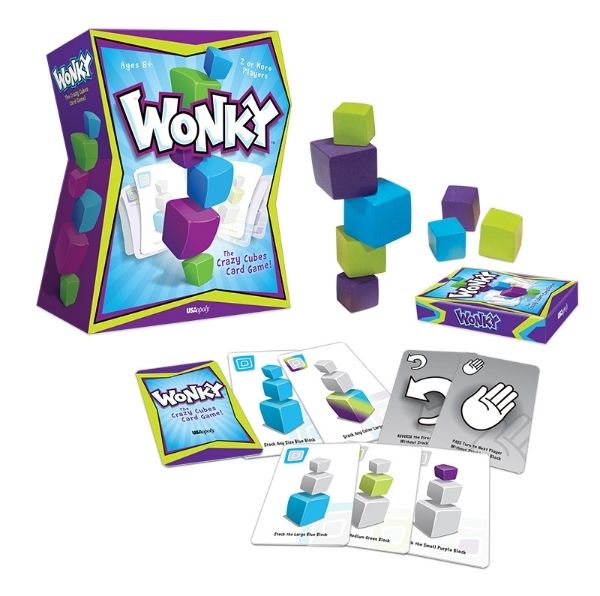The boys were very excited to receive a box from USAopoly last month with two games in it: Wonky: The Crazy Cubes Card Game and Tapple: Fast Word Fun for Everyone. The box was ripped open immediately. Since Papa was home from work that week, he played both games with them right away. Since that day, both games have gotten lots of use. Tapple even got taken along in the van on errand day to keep the big boys content while I took care of baby AJ's needs.
Wonky: The Crazy Cubes Card Game

Wonky is played with cards and nine slightly oddly-shaped wooden blocks in three different sizes and colours.
Players each receive a hand of cards, and the tallest player begins the game by playing a card and placing its corresponding block on the table.
Play proceeds until *CRASH!* the tower falls. The player responsible for the crash must pick up more cards (This is not good, since the object of the game is to get rid of all your cards!).
It can be a challenge to stack the blocks, especially if your hand of cards only has large blocks after smaller blocks have already been played. Thankfully, there are some special action cards that allow you to skip your turn, change the direction of play, or get your opponents to pick up extra cards.
To win, you must either play all your cards, or successfully place the ninth block on the tower. We have not managed a nine-block tower yet.
This game is recommended for ages eight and up, but both my seven-year-old and five-year-old had no problems playing. SA(7) really enjoyed this game, and I know it will continue to be a favourite with him. JJ(5) enjoyed it as well, but lost interest if a round lasted longer than ten minutes.
One thing we noticed is that playing Wonky on the floor worked better than playing it on the table. Anyone jiggling the table could cause the whole tower to come crashing down. The floor allowed for more stable towers (as long as the baby wasn't around!).
Tapple: Fast Word Fun for Everyone
Tapple is a fast-paced, addicting word game. It is played with category cards and a "Tapple Wheel" containing twenty letters and a ten-second timer. The beginning player chooses the category "In This Room," and we're off!
The beginning player chooses the category "In This Room," and we're off!Player 1: (tap C) Chairs! (hit timer)
Player 2: (tap P) Piano! (hit timer)
Player 3: (tap B) Books! (hit timer)
Player 1: (mind blank.) ... (timer dings!) Player is out!
Player 2: (tap D) Drum! (hit timer)
Play goes on until there is only one person left. That person gets the category card and a new round is begun. The first person to collect three category cards wins the game.
Tapple was my favourite of the two games, though my mind went blank at the crucial moment far too often! It was especially fun to play with a slightly larger group when we took it along to Grandma and Grandpa's for our weekly game time. It was also great as a fast two-player game.
This game is also recommended for ages eight and up, but SA(7) had no problem with it. We modified the rules a bit when playing with JJ(5). We allowed him to choose any word beginning with the correct letter, rather than having him stick to the category. I found this game lent itself well to modification depending on the needs of the players, whether for more challenge or for less. We even allowed MM(3) to play, just allowing him to tap a letter and hit the timer on his turn without saying a word. This left fewer options for the remaining players, but it was hard to play this game at our house without including him. The ticking and dinging timer is like a magnet for three-year-old boys!
Overall, we had a lot of fun with these two games from USAopoly. We will continue to play them often, and that's a high recommendation coming from me!
For more reviews, check out the link below:








